|
Pitzer Woods
Battle of Gettysburg
Pitzer’s Woods Battle of Gettysburg, Seminary Ridge Warfield Ridge Cemetery Ridge Hill Pitzer
Woods Battle of Gettysburg, General Daniel Sickles Wilcox's Brigade General Barksdale Emmitsburg Road
Pitzer Woods and Battle of Gettysburg
Introduction
Pitzer Woods was contested ground during the Battle of Gettysburg on July
1-2, 1863.
South Seminary Ridge is the portion of the battlefield south of an east-west
branch of Pitzer Run, which separates South Seminary Ridge from a separate landform to the north on the west of Gettysburg
with the Lutheran Theological Seminary at Gettysburg. South of the Pitzer Run branch, the ridgeline of South Seminary Ridge
extends from Pitzer Woods, across the Millerstown Road.
The first day at Gettysburg—more significant than simply a prelude to the bloody second and third
days—ranks as the 23rd largest battle of the war by number of troops engaged. About one quarter of Meade's army
(22,000 men) and one third of Lee's army (27,000) were engaged. Union casualties were almost 9,000, Confederate slightly more
than 6,000. The first day of the battle of Gettysburg (at McPherson’s Ridge, Oak Hill, Oak Ridge, Seminary Ridge, Barlow’s
Knoll and in and around the town) involved some 50,000 soldiers of which roughly 15,500 were killed, wounded, captured or
missing. The initial day in itself ranks as the 12th bloodiest battle of the Civil War.
The second day of the battle, July 2, was the largest and costliest of the three days. The second day’s fighting (at Devil’s Den, Little Round Top, the Wheatfield, the Peach Orchard, Cemetery
Ridge, Trostle’s Farm, Culp’s Hill and Cemetery Hill) involved at least 100,000 soldiers of which roughly 20,000
were killed, wounded, captured or missing. The second day in itself ranks as the 10th bloodiest battle of the Civil War—with
far more casualties than the much larger Battle of Fredericksburg.
| Battle of Gettysburg, July 2, 1863 |
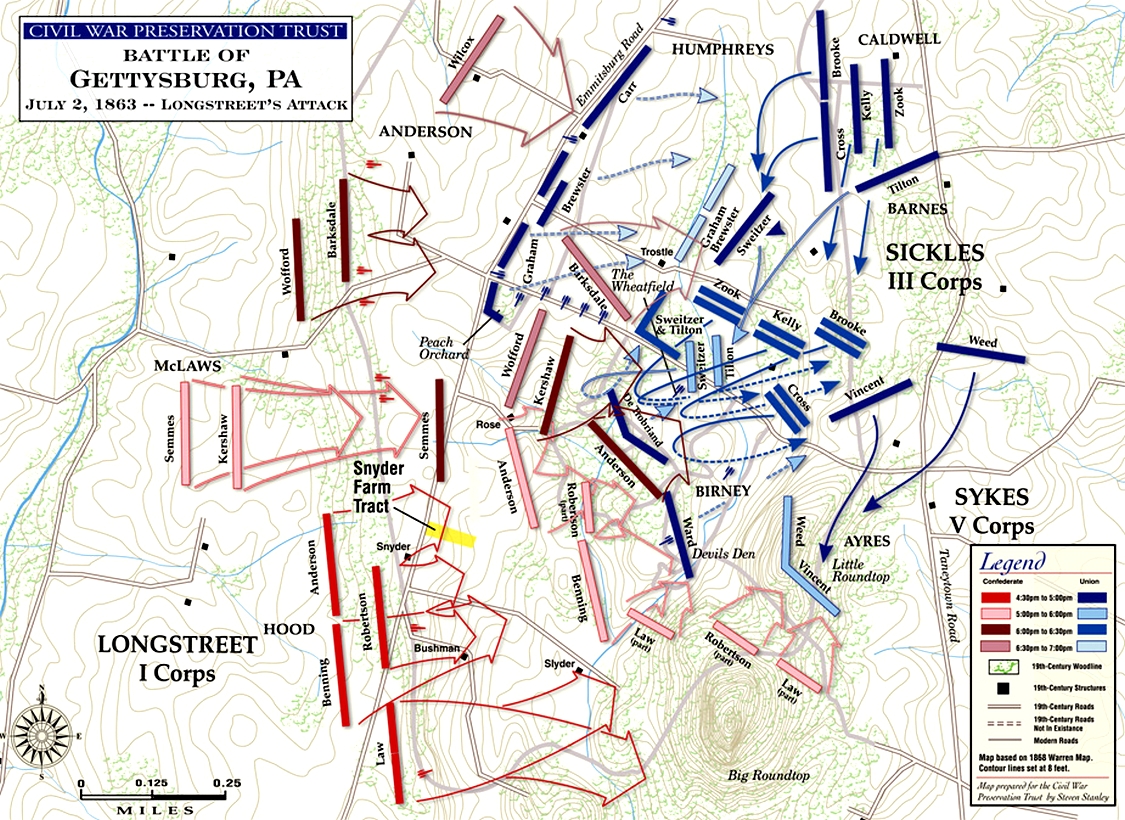
|
| Second Day of the Fighting at Gettysburg |
| Pitzer Woods, Gettysburg |
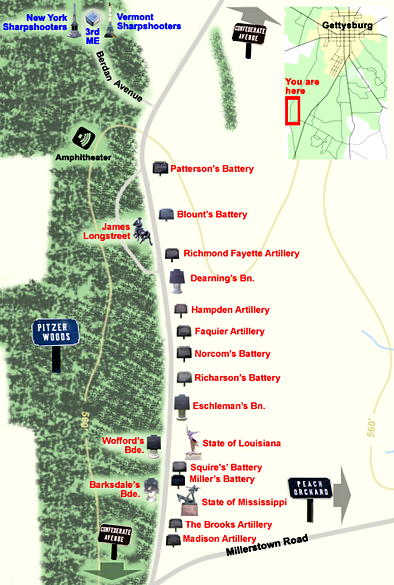
|
| Pitzer Woods, Battle of Gettysburg |
Summary
On the first day of the Battle of Gettysburg, Cemetery Ridge was unoccupied
for much of the day until the Union army retreated from its positions north of town, when the divisions of Brig. Gen. John
C. Robinson and Maj. Gen. Abner Doubleday from the I Corps were placed on the northern end of the ridge, protecting the left
flank of the XI Corps on Cemetery Hill. After the XII Corps arrived, Maj. Gen. John W. Geary's Second Division was sent to
the southern end of the ridge near Little Round Top; Brig. Gen. John Buford's cavalry division formed a skirmish line in the
fields between Cemetery Ridge and Seminary Ridge. The III Corps arrived about 8 p.m. and replaced Geary's division (which
was sent to Culp's Hill); the II Corps arrived about 10:30 p.m. and camped immediately behind the III Corps.
During the morning of the 2nd day (July 2), Army of the Potomac commander
Maj. Gen. George G. Meade shifted units to receive an expected Confederate attack on his positions. The II Corps was placed
in the center of Cemetery Ridge, with Brig. Gen. Alexander Hays's division on the corps' right, John Gibbon's division in
the center around the Angle, and John C. Caldwell's division on the left, adjacent to the III Corps; Robinson's division of
the I Corps was placed in reserve behind the XI Corps. The V Corps was formed in reserve behind the II Corps. In the late
afternoon, the end of the Confederate Maj. Gen. Lafayette McLaws's assault drove portions of Maj. Gen. Daniel Sickles's III
Corps line back to the southern end of Cemetery Ridge, and Brig. Gen. Ambrose Wright's Confederate brigade temporarily captured
the southern end of the Angle before being driven back to Seminary Ridge by the Philadelphia Brigade.
The Confederate artillery bombardment preceding Pickett's Charge on July
3 battered Cemetery Ridge, and Union artillery on the ridge counterfired to Seminary Ridge. Thirty-four Union cannons were
disabled, but the three Confederate divisions of the subsequent infantry assault (Pickett's of the First Corps and Pettigrew's
and Trimble's of the Third Corps), attacked the Union II Corps at the "stone fence" at the Angle. Heavy rifle and artillery
fire prevented all but about 250 Confederates led by Lewis Armistead from penetrating the Union line to the high water mark
of the Confederacy. Armistead was mortally wounded. Two brigades of Anderson's Division, assigned to protect Pickett's right
flank during the charge, reached a more southern portion of the Union line at Cemetery Ridge soon after the repulse of Pickett's
Division, but were driven back with 40% casualties by the 2nd Vermont Brigade.
On July 3, fighting resumed on Culp's Hill, and cavalry battles raged to
the east and south, but the main event was a dramatic infantry assault by 12,000 Confederates, known as Pickett's Charge, against
the center of the Union line on Cemetery Ridge. The charge was repulsed by Union rifle and artillery fire, at great losses
to the Confederate army. Lee led his army on a torturous retreat back to Virginia. As many as 51,000 soldiers from both armies
were killed, wounded, captured or missing in the three-day battle.
| Pitzer Woods |
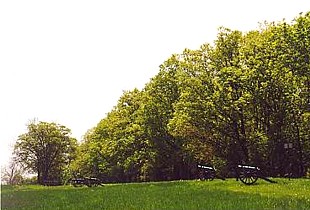
|
| Pitzer Woods, Gettysburg |
History
Owned at the time of the battle by farmer Samuel Pitzer, this plot of oaks
and maples stands at the southern tip of Seminary Ridge and marks its juncture with Warfield Ridge. The woods had no significance at all to the Gettysburg landscape until certain
events took place here on July 2. Just prior to midday, the 1st United States Sharpshooters were ordered by Major General
Daniel Sickles, commander of the Union Third Corps, to scout this patch of woods. Accompanied by members of the 3rd Maine
Infantry, the sharpshooters encountered Alabama soldiers from Brig. General Cadmus Wilcox's Brigade. A brisk fire fight broke
out and though it lasted only a few moments, the Union soldiers withdrew with the knowledge that the woods on Seminary Ridge
were teeming with Confederates. Returning to Cemetery Ridge, they reported their encounter to General Sickles who realized that the number
of Confederates in those woods meant only one thing- a heavy, concentrated attack on his corps from the west. Sickles sent
a courier to General Meade with the information, followed by another courier a half hour later. Another hour passed and having
received no response from Meade, Sickles decided to advance his corps to the Emmitsburg Road, the only high ground between
the two ridges where he would meet the attack before they'd taken possession of it. This controversial decision separated
his corps from the remainder of the Union army, which still lay on Cemetery Ridge.
| Gen. Barksdale |

|
| (Generals in Gray) |
Later that afternoon, Confederate troops of Lieutenant General James Longstreet's Corps marched into this area, with the left of his line anchored in Pitzer Woods by
the Mississippi Brigade of Brig. General William Barksdale. The Georgia brigade of Brig. General W.T. Wofford formed just
outside of the woods, but close behind Barksdale's men who were thankful for the shade under which they rested. The objective
for Barksdale and Wofford was to attack Union troops forming on the Emmitsburg Road and the salient of the advanced line at
the Peach Orchard.
| Emmitsburg Road |
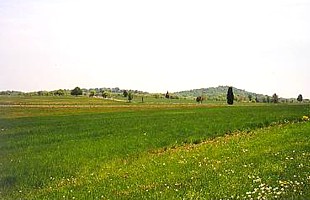
|
| Peach Orchard from Pitzer Woods |
Just before 4 o'clock, Confederate artillery along this portion of Seminary Ridge opened fire on the Union
batteries stationed in the Peach Orchard. Huddling in the woods, the Mississippi troops listened to the boom of the guns and
screech of Union shells crashing through the trees above them. Impatient that his part of the attack was delayed until other
troops had gone in first, a fuming Barksdale stormed up and down, stopping only to petition his division commander for permission
to go into the attack early.
(Left) View toward the Peach Orchard from Pitzer Woods. Barksdale's Brigade
charged over this open field toward Union defenders in the distance. The Round Tops rise in the distance just beyond the orchard.
Photo Gettysburg NMP.
Almost two hours into the attack, the hot tempered general was given permission to move forward in support
of Confederate troops advancing on their right. Barksdale ordered his men to the eastern edge of the woods where the Mississippians
dressed their ranks and went to the position of "parade rest" while Union shells burst around them. Though considered a senior
in age, General Barksdale was a fiery and fearless leader in battle whose face appeared to "glow with excitement at the prospect
of battle." Dressed in a resplendent gray officer's coat highlighted with gold trim, his long gray hair flowing almost to
the collar, Barksdale spurred his black charger to the front of his old regiment, the 13th Mississippi. Above the din of battle,
the general spoke a few words of encouragement. He then waved his hat as a signal to begin the charge and his brigade moved
forward in an unstoppable wave.
| Official Battle of Gettysburg Map |
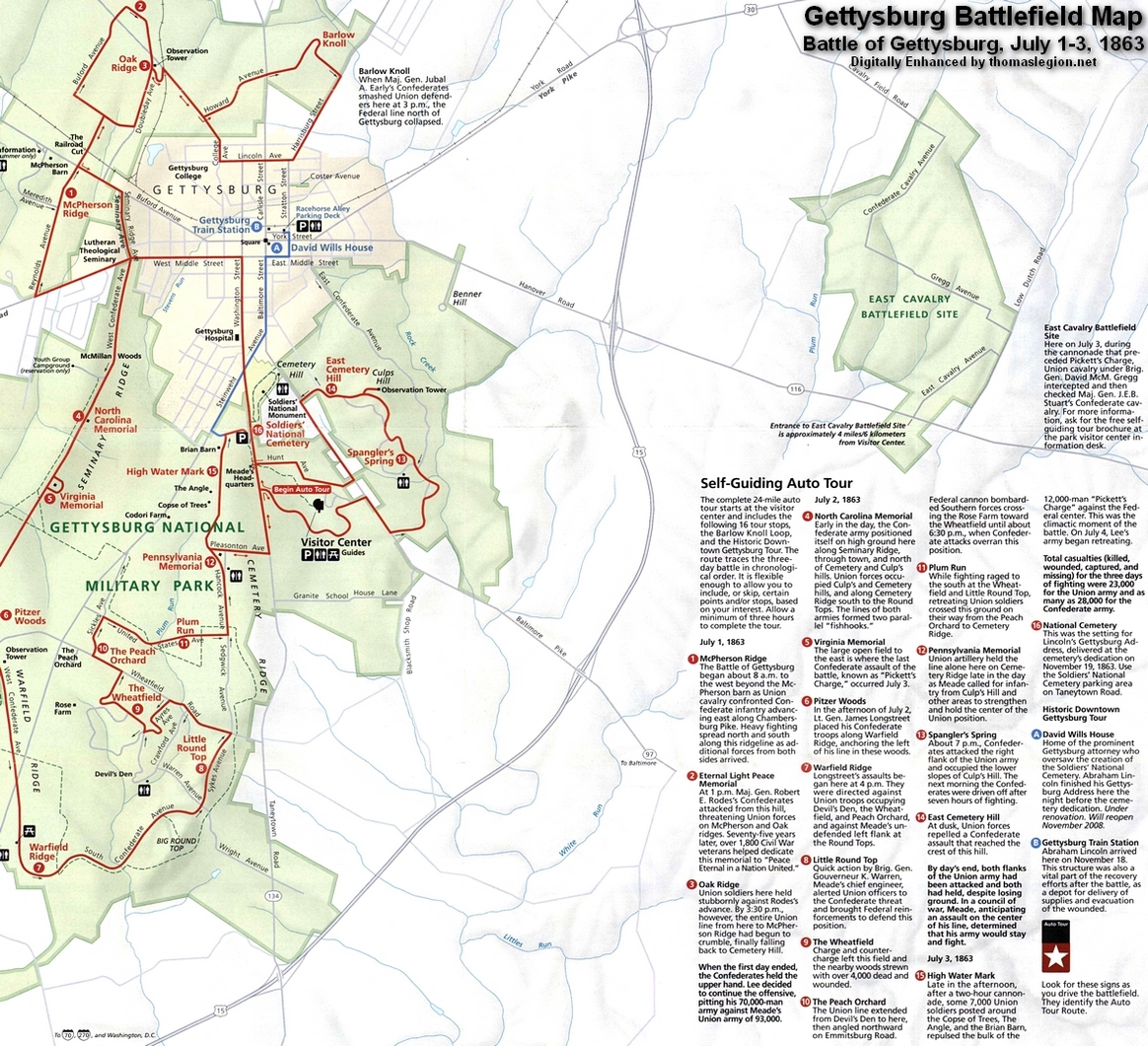
|
| Official Pitzer Woods and Gettysburg Battlefield Map |
The Mississippi Brigade raced across open fields and sliced through the Union
line. It was "The most magnificent charge of the war," as one eyewitness called it. Despite the heroic efforts of two Union
regiments near the Sherfy House to slow the Mississippians, Barksdale's soldiers broke through the shaken Union defenders
in the Peach Orchard and the precarious Union line began to collapse. Wofford's Georgians followed in Barksdale's path and
eventually drove in the last defenders of the orchard before they reached the Wheatfield and beyond, which you will visit
as you continue the tour.
Samuel Pitzer's farmhouse still stands today, approximately 400 yards west
of the woods for which he is named, and is today part of Eisenhower National Historic Site. The size and shape of these woods
has changed very little since the battle, despite the placement of a Civilian Conservation Corps camp here in 1935 and the
park amphitheater installed within the woods during the 1960's. The 1999 General Management Plan for Gettysburg National Military
Park calls for the relocation of the amphitheater in the near future, and Pitzer Woods will return to its 1863 appearance.
| Mississippi State Monument |
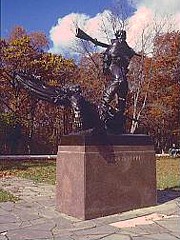
|
| Mississippi State Monument |
Mississippi Honors Her Sons at Gettysburg
The Mississippi State Monument stands near this location, selected for this
site because of the service of General Barksdale's Mississippi Brigade on July 2. Dedicated in 1973, the bronze soldiers atop
the polished granite base depict the fighting spirit of the Mississippi soldiers who fought at Gettysburg. Sculptor Donald
DeLue wrote that the monument, "expresses (the) bitter fighting on both sides. But, here on the Confederate side the tide
has turned against them, ammunition gone, the flag down, only the courage of desperation remains to the courageous young soldier...",
which aptly describes the closing scenes of Barksdale's charge, which not only broke the advanced Union line at the Peach
Orchard, but also threatened to open a serious breach in the center of the Union line on Cemetery Ridge. Only the most desperate
of measures taken by Union defenders threw the Mississippi regiments back.
(Right) The Mississippi State Monument.
Adjacent to the Mississippi Monument is the Louisiana State Monument, also
sculpted by DeLue, and dedicated in 1971. The famed "Washington Artillery of New Orleans" was positioned near this location
on July 2 and pushed forward to the Peach Orchard on July 3, prior to the bombardment of the Union line. It was two guns from
the Washington Artillery that fired the opening shots to begin the cannonade prior to "Pickett's Charge". Behind both monuments and set within Pitzer Woods, stands the monument to
General James Longstreet sculpted by Gary Casteel. One of the more recent monuments on the battlefield, it was sponsored by
the North Carolina Division of the Sons of Confederate Veterans and dedicated on July 3, 1998.
| US Sharpshooter Monument |
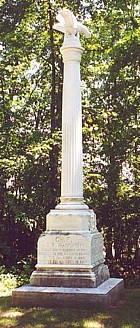
|
| Co. F, 1st USSS Monument |
Also within Pitzer Woods is Berdan Avenue, which leads from West Confederate
Avenue to a small cul-de-sac where three monuments stand. Two of these are to companies of the 1st United States Sharpshooters,
often referred to as "Berdan's Sharpshooters". At the beginning of the Civil War, Hiram Berdan submitted a proposal to the
US War Department to raise a regiment of soldiers who were expert marksmen. The regiment would be composed of companies from
Northern or "loyal" states, and to qualify for enlistment in the sharpshooters, men had to be able to hit a target with ten
consecutive bulls eyes at 200 yards. Men could provide their own weapons or rely on a rifle given by the government. There
was such a clamor of men to join the sharpshooters that two regiments were raised. Berdan was appointed colonel of the 1st
USSS and organized his first regiment at Weehawken, New York. The 2nd Regiment soon joined the 1st and both units were uniformed
with a distinctive green coat, cap and trousers made of fine wool broadcloth that gave them the nickname of "Green Coats".
Even more distinctive were the accurate Colt Revolving Rifles and breech-loading Sharps
Rifles that Colonel Berdan secured for both regiments. The US Sharpshooters saw their first combat during the Seven Days Battles before Richmond and then were active throughout all of the campaigns
of the Army of the Potomac.
At Gettysburg, Company F (Vermont troops)
1st USSS, was one of the companies sent forward by General Sickles to reconnoiter the front of the Third Corps. It was at
the spot where their monument sits that the sharpshooters engaged several regiments of General Cadmus Wilcox's Brigade.
The distinctive marble shaft and hand-carved stone eagle atop the monument were both knocked over and shattered by a falling
tree during a windstorm in 1991. It was only through the interest and donations of outside parties that the shaft and eagle
were restored to the monument in May 2000.
Sources: National Park Service; Gettysburg National Military Park; Civil
War Trust; National Archives; Library of Congress; Official Records of the Union and Confederate Armies.
Recommended Reading: Gettysburg: A Testing of Courage. Description: America's Civil War raged for more than four years, but it is the three days of fighting in the Pennsylvania countryside in July 1863 that continues to fascinate, appall, and inspire new
generations with its unparalleled saga of sacrifice and courage. From Chancellorsville, where General Robert E. Lee launched
his high-risk campaign into the North, to the Confederates' last daring and ultimately-doomed act, forever known as Pickett's
Charge, the battle of Gettysburg gave the Union army a victory that turned back the boldest and perhaps greatest chance for
a Southern nation. Continued below...
Now, acclaimed
historian Noah Andre Trudeau brings the most up-to-date research available to a brilliant, sweeping, and comprehensive history
of the battle of Gettysburg that sheds fresh light on virtually every aspect of it. Deftly balancing his own
narrative style with revealing firsthand accounts, Trudeau brings this engrossing human tale to life as never before.
Recommended
Reading:
General Lee's Army: From Victory to Collapse. Review:
You cannot say that University of North
Carolina professor Glatthaar (Partners in Command) did not do his homework in this massive examination
of the Civil War–era lives of the men in Robert E. Lee's Army of Northern Virginia. Glatthaar spent nearly 20 years
examining and ordering primary source material to ferret out why Lee's men fought, how they lived during the war, how they
came close to winning, and why they lost. Glatthaar marshals convincing evidence to challenge the often-expressed notion that
the war in the South was a rich man's war and a poor man's fight and that support for slavery was concentrated among the Southern
upper class. Continued below...
Lee's army
included the rich, poor and middle-class, according to the author, who contends that there was broad support for the war in
all economic strata of Confederate society. He also challenges the myth that because Union forces outnumbered and materially
outmatched the Confederates, the rebel cause was lost, and articulates Lee and his army's acumen and achievements in the face
of this overwhelming opposition. This well-written work provides much food for thought for all Civil War buffs.
Recommended Reading: The Maps of Gettysburg:
The Gettysburg Campaign, June 3 - July 13, 1863
(Hardcover). Description: More academic and photographic
accounts on the battle of Gettysburg exist than for all other
battles of the Civil War combined-and for good reason. The three-days of maneuver, attack, and counterattack consisted of
literally scores of encounters, from corps-size actions to small unit engagements. Despite all its coverage, Gettysburg remains one of the most complex and difficult to understand battles of the war.
Author Bradley Gottfried offers a unique approach to the study of this multifaceted engagement. The Maps of Gettysburg plows
new ground in the study of the campaign by breaking down the entire campaign in 140 detailed original maps. These cartographic
originals bore down to the regimental level, and offer Civil Warriors a unique and fascinating approach to studying the always
climactic battle of the war. Continued
below...
The Maps of
Gettysburg offers thirty "action-sections" comprising the entire campaign. These include the march to and from the battlefield,
and virtually every significant event in between. Gottfried's original maps further enrich each "action-section." Keyed to
each piece of cartography is detailed text that includes hundreds of soldiers' quotes that make the Gettysburg
story come alive. This presentation allows readers to easily and quickly find a map and text on virtually any portion of the
campaign, from the great cavalry clash at Brandy Station on June 9, to the last Confederate withdrawal of troops across the
Potomac River on July 15, 1863. Serious students of the battle will appreciate the extensive
and authoritative endnotes. They will also want to bring the book along on their trips to the battlefield… Perfect for
the easy chair or for stomping the hallowed ground of Gettysburg,
The Maps of Gettysburg promises to be a seminal work that belongs on the bookshelf of every serious and casual student of
the battle.
Recommended
Reading: Shock Troops
of the Confederacy (Hardcover) (432 pages). Description: Fred Ray's Shock Troops of the Confederacy is primarily focused
on the "sharpshooter battalions" of the Army of Northern Virginia. In a Civil War context, "sharpshooter" was usually more
akin to "skirmisher" than "sniper," although these specialized battalions also used innovative open order assault techniques,
especially late in the war. Continued below...
Ray includes,
however, a detailed study of Union sharpshooter battalions and Confederate sharpshooters in the West. Remarkably, little
has been published about such organizations in the past, so Fred Ray's book offers a unique study of the evolution of Civil
War infantry tactics, revealing a more complex, sophisticated approach to the battlefield than is usually understood.
Recommended Reading: Hallowed Ground: A Walk at Gettysburg, by James M. Mcpherson (Crown Journeys) (Hardcover). Review From
Publishers Weekly: The country's most distinguished
Civil War historian, a Pulitzer Prize winner (for Battle Cry of Freedom) and professor at Princeton,
offers this compact and incisive study of the Battle of Gettysburg. In narrating "the largest battle ever fought in the Western Hemisphere," McPherson walks readers over its presently hallowed ground, with monuments numbering
into the hundreds, many of which work to structure the narrative. Continued below...
They range
from the equestrian monument to Union general John Reynolds to Amos Humiston, a New Yorker identified several months after
the battle when family daguerreotypes found on his body were recognized by his widow. Indeed, while McPherson does the expected
fine job of narrating the battle, in a manner suitable for the almost complete tyro in military history, he also skillfully
hands out kudos and criticism each time he comes to a memorial. He praises Joshua Chamberlain and the 20th Maine, but also the 140th
New York and its colonel, who died leading his regiment
on the other Union flank in an equally desperate action. The cover is effective and moving: the quiet clean battlefield park
above, the strewn bodies below. The author's knack for knocking myths on the head without jargon or insult is on display throughout:
he gently points out that North Carolinians think that their General Pettigrew ought to share credit for Pickett's charge;
that General Lee's possible illness is no excuse for the butchery that charge led to; that African-Americans were left out
of the veterans' reunions; and that the kidnapping of African-Americans by the Confederates has been excised from most history
books.
Recommended
Reading: The Gettysburg
Companion: A Guide to the Most Famous Battle of the Civil
War (Hardcover). Description: There have
been many books about Gettysburg, but never one to rival this
in scale or authority. Based on extensive research, The Gettysburg Companion describes the battle in detail, drawing on firsthand
accounts of participants on all sides in order to give the reader a vivid sense of what it was like to experience the carnage
at Gettysburg in early July 1863. The many full-color maps--all
specially commissioned for the book--and the numerous photographs, charts, and diagrams make this book a feast for the eyes
and a collector's dream. Includes a massive library of 500 color illustrations.
Recommended Reading: ONE CONTINUOUS
FIGHT: The Retreat from Gettysburg and the Pursuit of Lee's Army of Northern
Virginia, July 4-14, 1863 (Hardcover) (June 2008). Description: The titanic three-day battle of Gettysburg
left 50,000 casualties in its wake, a battered Southern army far from its base of supplies, and a rich historiographic legacy.
Thousands of books and articles cover nearly every aspect of the battle, but not a single volume focuses on the military aspects
of the monumentally important movements of the armies to and across the Potomac River. One
Continuous Fight: The Retreat from Gettysburg and the Pursuit
of Lee's Army of Northern Virginia, July 4-14, 1863 is the first detailed military history of Lee's retreat and the Union
effort to catch and destroy the wounded Army of Northern Virginia. Against steep odds and encumbered with thousands of casualties,
Confederate commander Robert E. Lee's post-battle task was to successfully withdraw his army across the Potomac River. Union
commander George G. Meade's equally difficult assignment was to intercept the effort and destroy his enemy. The responsibility
for defending the exposed Southern columns belonged to cavalry chieftain James Ewell Brown (JEB) Stuart. If Stuart fumbled
his famous ride north to Gettysburg, his generalship during
the retreat more than redeemed his flagging reputation. The ten days of retreat triggered nearly two dozen skirmishes and
major engagements, including fighting at Granite Hill, Monterey Pass,
Hagerstown, Williamsport, Funkstown,
Boonsboro, and Falling Waters. Continued
below...
President Abraham
Lincoln was thankful for the early July battlefield victory, but disappointed that General Meade was unable to surround and
crush the Confederates before they found safety on the far side of the Potomac. Exactly what Meade did to try to intercept the fleeing Confederates, and how the
Southerners managed to defend their army and ponderous 17-mile long wagon train of wounded until crossing into western Virginia on the early morning of July 14, is the subject of this study.
One Continuous Fight draws upon a massive array of documents, letters, diaries, newspaper accounts, and published primary
and secondary sources. These long-ignored foundational sources allow the authors, each widely known for their expertise in
Civil War cavalry operations, to describe carefully each engagement. The result is a rich and comprehensive study loaded with
incisive tactical commentary, new perspectives on the strategic role of the Southern and Northern cavalry, and fresh insights
on every engagement, large and small, fought during the retreat. The retreat from Gettysburg
was so punctuated with fighting that a soldier felt compelled to describe it as "One Continuous Fight." Until now, few students
fully realized the accuracy of that description. Complimented with 18 original maps, dozens of photos, and a complete driving
tour with GPS coordinates of the entire retreat, One Continuous Fight is an essential book for every student of the American
Civil War in general, and for the student of Gettysburg in
particular. About the Authors: Eric J. Wittenberg has written widely on Civil War cavalry operations. His books include Glory
Enough for All (2002), The Union Cavalry Comes of Age (2003), and The Battle of Monroe's Crossroads and the Civil War's Final
Campaign (2005). He lives in Columbus, Ohio.
J. David Petruzzi is the author of several magazine articles on Eastern Theater cavalry operations, conducts tours of cavalry
sites of the Gettysburg Campaign, and is the author of the popular "Buford's Boys." A long time student of the Gettysburg
Campaign, Michael Nugent is a retired US Army Armored Cavalry Officer and the descendant of a Civil War Cavalry soldier. He
has previously written for several military publications. Nugent lives in Wells, Maine.
|

